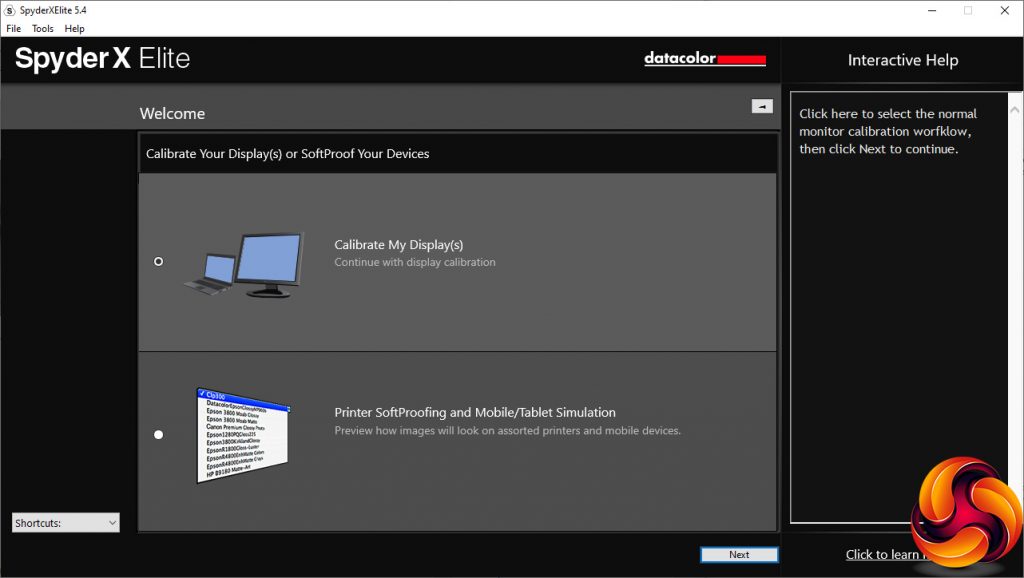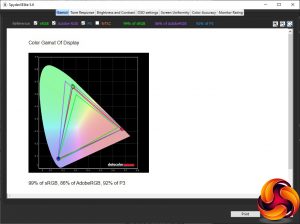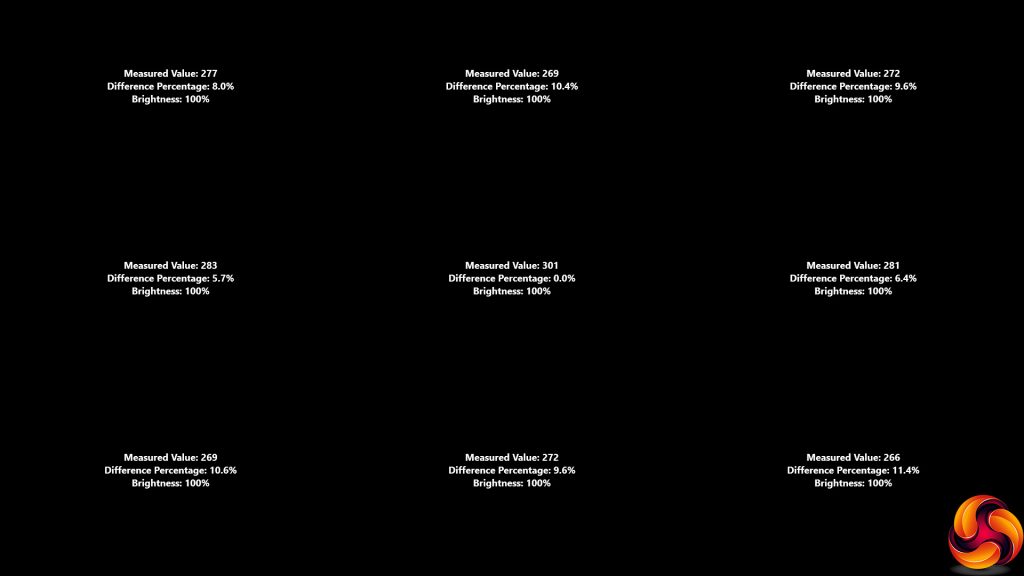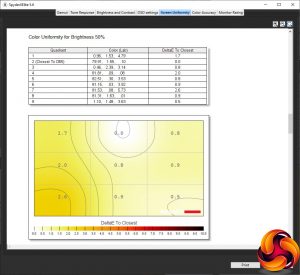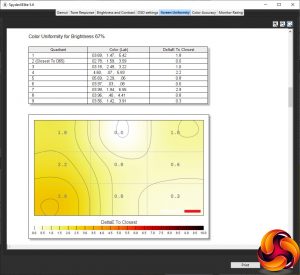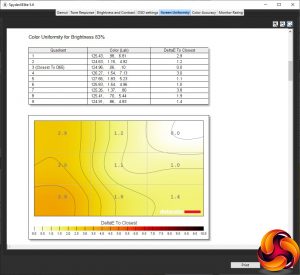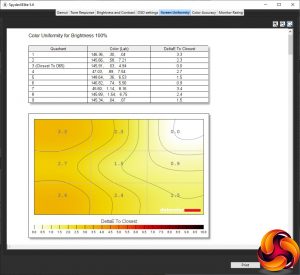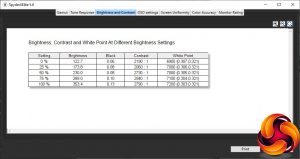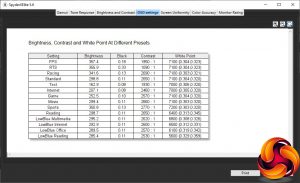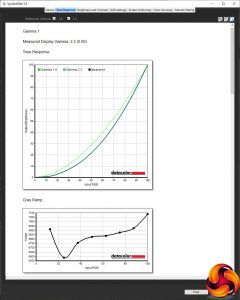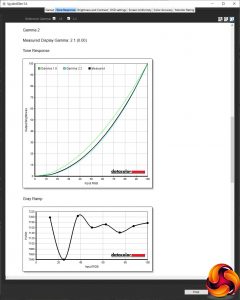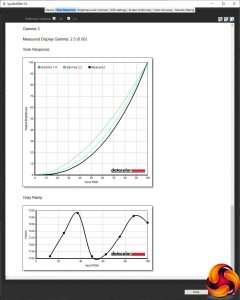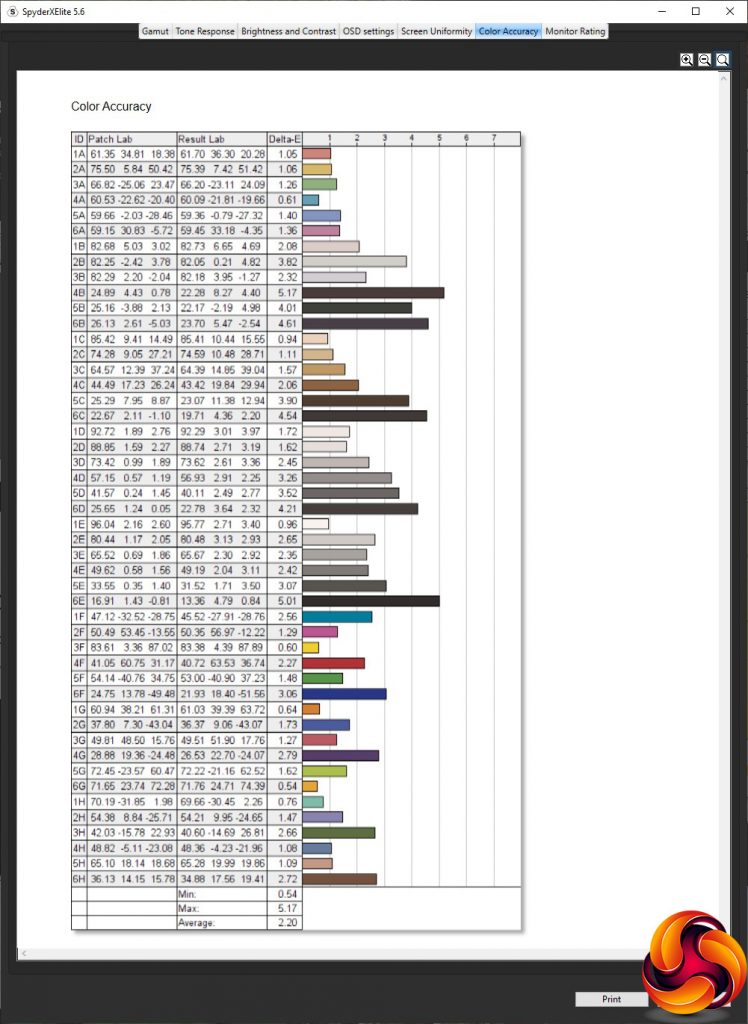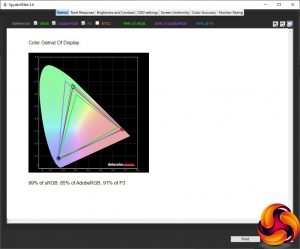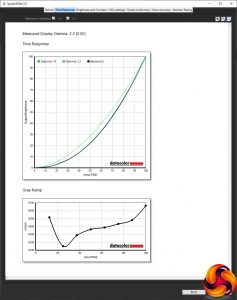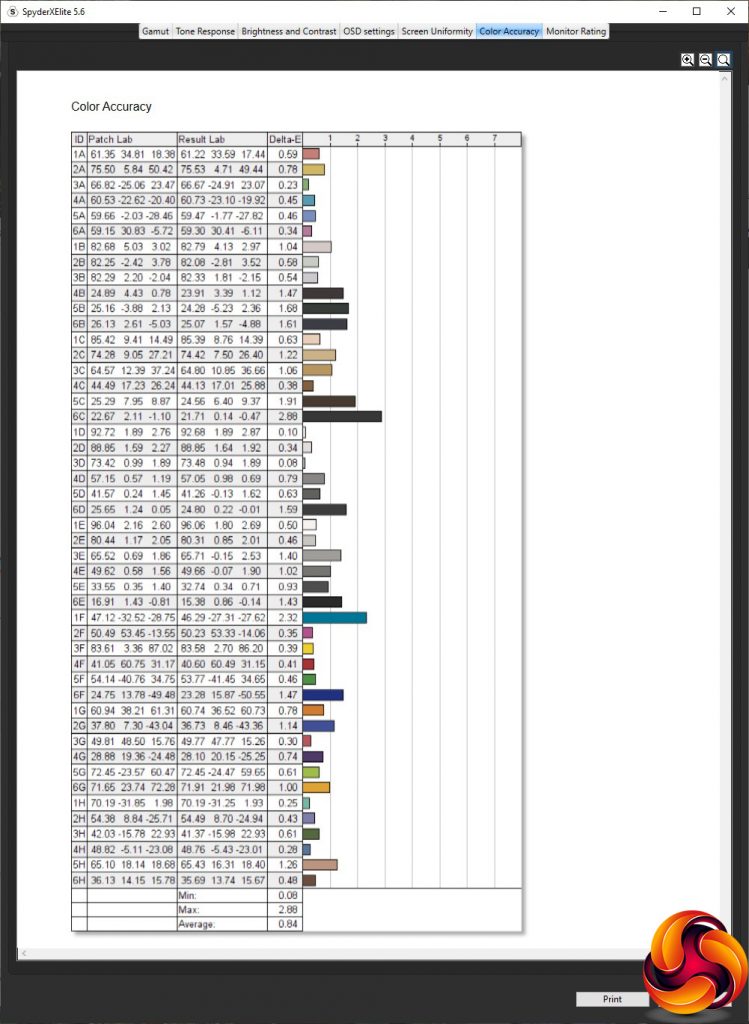Our main test involves using a DataColor SpyderX Colorimeter to assess a display’s image quality. The device sits on top of the screen while the software generates colour tones and patterns, which it compares against predetermined values to work out how accurate the screen is.
The results show –
- A monitor’s maximum brightness in candelas or cd/m2 at various levels set in the OSD.
- A monitor’s contrast ratio at various brightness levels in the OSD.
- The brightness deviation across the panel.
- The black and white points.
- The colour accuracy, expressed as a Delta E ratio, with a result under 3 being fine for normal use, and under 2 being great for colour-accurate design work.
- The exact gamma levels, with a comparison against preset settings in the OSD.
We first run this test with the display in its default, out-of-the-box state, with all settings on default. We then calibrate the screen using the Spyder software and run the test again.
We always test the display subjectively on the Windows desktop, using it for general tasks such as browsing and word processing, and with games as well, even if the display is not intended solely for that purpose.
We pay careful attention to any artefacts, ghosting or motion blur, and enable any gaming-specific features, such as adaptive-sync settings like G-Sync or FreeSync, using a compatible graphics card in our test PC.
We performed the quality tests on the AOC C32G2ZE at its native 1,920 x 1,080 resolution in the default mode, after resetting the OSD, which sets the refresh to 60Hz. Our test system was equipped with an AMD Radeon Vega Frontier Edition graphics card, which supports FreeSync.
The gamut makes for a decent albeit slightly surprising start. On the one hand, it's a surprise that the the sRGB result is 99 per cent rather than 100 per cent, but the AdobeRGB score of 86 per cent is very good, with an even more impressive 92 per cent DCI-P3 gamut.
Brightness uniformity is good for the top two thirds of the screen, but the bottom third hovers a little too much around the 10 per cent deviation mark.
Colour uniformity, however, is great at all brightness levels.
The C32G2ZE is rated at 300cd/m2 brightness, but actually hits that at around an 80 per cent setting. The 100 per cent value is 353.4cd/m2, which is decent enough for a VA panel. The contrast levels are excellent, topping out at 2,940:1 with the 75 per cent brightness setting. Considering that we don't put contrast on maximum for this test, the specified value of 4,000:1 seems realistic. The white point is also in a good range, from 6900K at 0 per cent brightness to 7200K at 100 per cent.
We have combined all the different presets into one list here, starting with the Game Modes. The FPS and RTS modes use near-maximum brightness levels of 357.4cd/m2 and 355.9cd/m2 respectively, and Racing is only a little less bright at 341.6cd/m2. They also use an identical 7100K white point. Where they vary is in contrast, with FPS using a mid-range (for this screen) 1,950:1, but RTS a much lower 1,090:1 and Racing a higher 2,690:1.
Next we move to the Eco Modes, which are essentially the everyday presets. Standard mode is the default, offering a brightness of 298.8cd/m2, 2,650:1 contrast and 7100K white point. In fact, most of these presets have similar white points, with Game and Movie also using 7100K, Text and Internet 7000K, and Sports 7200K. Only Reading uses a warmer 6400K, as you'd expect for an activity that is likely to involve staring at a static screen for long periods.
Text mode, however, uses the lowest brightness of 162.9cd/m2, with a mid-range 1,930:1 contrast. Internet mode is a little brighter at 207.1cd/m2, with a higher 2,460:1 contrast. Game mode is brighter still at 252.5cd/m2, while Movie and Reading have similar brightnesses of 299.4cd/m2 and 298.7cd/m2 respectively, but Sports is the brightest around at 350.8cd/m2. The first three have similar contrasts around the 2,600:1 mark, but Sports has a very high contrast of 2,770:1.
Finally, we get to the LowBlue modes, which are aimed at reducing eye strain. They all use a similar brightness of around 290cd/m2, and contrast in the range of 2,500:1 and 2,600:1. But the white points do vary, with Multimedia on 6800K, Internet on 6,500K, Office on 6100K and Reading on the warmest 5,600K. We might have expected these values to be lower, considering that removing blue from the spectrum makes colour temperature warmer.
As we always have to remark with AOC monitors, the gamma settings are a bit odd. The default Gamma 1 is reassuringly dead on 2.2, which is the usual middle of the gamma range. However, Gamma 2 is lower at 2.1 and Gamma 3 higher at 2.5. Not only are these not sequential, but they are not evenly spaced either.
At its default settings, the C32G2ZE only manages a decent 2.2 average colour accuracy deviation. Go back three or four years, and this would have been terrific, but now it's merely average. We expected more, which of course led us to try calibrating the screen to see what the best it could do was.
After calibration, the gamut has reduced slightly. The sRGB score is the same at 99 per cent, but AdobeRGB has dropped a notch to 85 per cent, and DCI-P3 is down to 91 per cent (a decrease of 1 per cent in both cases).
We only retested Gamma 1, which remains bang on 2.2
Colour accuracy has improved considerably, however, to 0.84, showing that the C32G2ZE has a quality panel capable of excellent fidelity when adjusted properly.
Overall, this is a good showing, particularly for a monitor that isn't that expensive. It's great to see a reasonably priced gaming monitor that doesn't skimp on everyday quality, with only the brightness aberration across the bottom third to mar a solid scorecard.
Of course, gaming is the main focus of this screen. So we called up on our test system's AMD Radeon Vega Frontier Edition graphics and FreeSync with our usual suite of games, including CS:GO for maximum frame rates, Rainbow 6 Siege, and League of Legends. This graphics card can drive CS:GO at the monitor's native resolution with frame rates that get close to the 240Hz refresh on a regular basis. The end result was an extremely smooth experience, with the curve adding immersion. Rainbow 6 was also very fluid, and the huge size worked well for League. Overall, this is a great screen for FPS gaming.
 KitGuru KitGuru.net – Tech News | Hardware News | Hardware Reviews | IOS | Mobile | Gaming | Graphics Cards
KitGuru KitGuru.net – Tech News | Hardware News | Hardware Reviews | IOS | Mobile | Gaming | Graphics Cards



